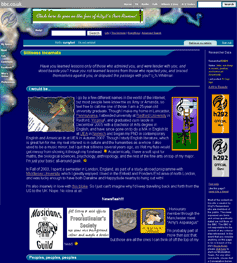Blogging at the BBC: Part 4 - Life, the Universe, and Everything
So far in this series about blogging at the BBC I have looked at the pioneering work of the BBC Scotland department in using a blog to supplement their WebGuide directory. Scotland was also the source of the 'Island Blogging' initiative, which saw remote communities on the fringes of Scotland given internet connections by the Scottish Assembly, and then blogging tools and an audience by the BBC.

This wasn't though, the BBC's first venture into user-generated blogging. They got into it rather by accident when they purchased the h2g2 site in 2001. The press release at the time stated that:
"The BBC announced today that it will launch www.bbc.co.uk/h2g2, a new community site from BBC New Media (on BBC ONLINE) designed to boost the BBC's existing work in building vibrant online communities, as part of its public service remit. The site will launch at the beginning of March 2001.
The new site results from the integration (without commercial references or links) of h2g2.com, the brainchild of Douglas Adams, creator of The Hitchhiker's Guide to the Galaxy - from which the h2g2 name is derived - after the BBC bought its content and software rights earlier in the year. The deal was proposed by h2g2.com following a long-term relationship with the BBC.
www.bbc.co.uk/h2g2 builds an online community where users can exchange ideas, comments and features on topics in which they have a shared interest. The sophisticated software involved permits exchanges and peer-to-peer reviews of user-generated content on an eclectic mix of subjects, creating a guide to 'life, the universe and everything'."
As part of the 'sophisticated' software, named DNA after the sadly missed Douglas Adams himself, the BBC also got a blogging platform.
OK, it wasn't called blogging at the time, but each h2g2 user had a Personal Space. This was like a homepage, and at the time, in the old 'Goo' skin, it was often littered with badges and animated graphics that made them look positively proto-MySpace in design terms.

Each 'Personal Space' also had a 'Journal' attached to it - essentially threaded conversations that you could start on your own page, which other people could leave comments on as well. The threads were time stamped, and had a permalink. A comment linked back to the 'Personal Space' of the person who had written it. It may have been a closed hootoosphere rather than part of the emerging blogosphere, but it was most definitely blog-like.
I remember that when the site opened there were a lot of BBC staff, myself included, desperate to join in the community and play around with the new features and software the Corporation had acquired. However, just prior to launch, an email went round asking that staff not swamp the h2g2 community as they got settled down into their new home.
h2g2.com had been offline for a few weeks whilst the system was integrated into the BBC site and server farm. This hiatus came to be known amongst the community as 'Rupert', and much of the first few weeks seemed to be spent moaning about the new operating rules that the BBC had bought into play, over both external links and moderation.
The BBC was not slow to grasp that the DNA software platform was a flexible tool that could be put to different community uses, and whilst the number of staff working on h2g2 steadily declined from 7 to one-and-a-half, the number of software engineers working on the DNA platform increased rapidly. At times, seemingly exponentially.
The BBC has subsequently used the software it got as part of the deal to take on h2g2 with varying degrees of success to power civic campaigning site Action Network (formerly iCan), to collect memories of the Second World War on The People's War, and to host BBC message boards like Points Of View and 606. There was even an ill-fated DNA community site 'Talk Buffy' dedicated to Buffy The Vampire Slayer - axed despite a petition trying to save it.

It was collective though, an online interactive alternative culture magazine, that used the term 'weblog' explicitly on the DNA platform for the first time. Originally launched in spring 2002 as a static site with a weekly newsletter, from September 2002 it subsequently used a re-skinned version of the h2g2 software to provide discussion areas, allow members to write reviews, and to keep a blog there.
Many of the features you would expect of an online blogging tool were present, except that users could not upload images, and, at first, there were no individual level RSS feeds available. Well, not without a bit of URL-hacking, anyway.
As several enterprising users and DNA experts found out, most of the time when launching a new site powered by the software, the BBC was seldom adding huge new features. It was often presenting to users a sub-set of the original h2g2 functionality, called different things - 'campaigns' rather than 'articles' for example. That meant people could manipulate the URL to exploit features that were not otherwise present, such as subscribing to a message board thread without having to contribute to it.
Whilst the BBC was gradually incorporating blogging into the then BBCi-branded experience on the web, I was just beginning to start posting here on currybetdotnet. Next week I'll be continuing this series by looking at what it was like to be blogging from inside the BBC.
Ahh, h2g2 and collective. Happy days...
Heh - and Talk Buffy came about because we just wanted a site that let users submit their own reviews on the same pages that we wrote our reviews on, so we could turn off our message boards.
We ended up with a more-or-less full install of DNA, which didn't properly integrate with the rest of the site. Humn.